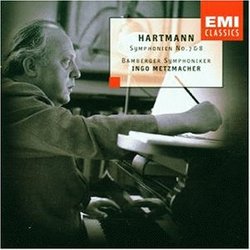| All Artists: Karl Amadeus Hartmann (Composer), Ingo Metzmacher (Conductor), Bamberg Symphony Title: Karl Amadeus Hartmann: Symphony No. 7, for Great Orchestra (1959) / Symphony No. 8, for Great Orchestra (1963) - Bamberg Symphony / Ingo Metzmacher Members Wishing: 0 Total Copies: 0 Label: EMI Classics Imports Release Date: 5/20/2000 Genre: Classical Style: Symphonies Number of Discs: 1 SwapaCD Credits: 1 UPC: 724355642721 |
Search - Karl Amadeus Hartmann (Composer), Ingo Metzmacher (Conductor), Bamberg Symphony :: Karl Amadeus Hartmann: Symphony No. 7, for Great Orchestra (1959) / Symphony No. 8, for Great Orchestra (1963) - Bamberg Symphony / Ingo Metzmacher
CD Details |
CD ReviewsSymphonie as document to what exists. scarecrow | Chicago, Illinois United States | 03/12/2004 (5 out of 5 stars) "It is quite incredible that the genre of the Symphonie lives on after Mahler. Mahler's Ninth Symphonie was a farewell to beauty,the Master Signifier and the images of childhood, the fragmented yet challenging experience of the metropolis. The transgression of beauty was to cloud over Europe in ways Mahler's imagination could hardly fathom. With Hartmann the Symphonie lives in a exiled world, it is not one free to speak, it is one where the voice, (as Agamben says someplace) carries Being, yet in what form? It is a voice smashed from the SS jackboots, a voice of the dispossessed and the homeless.It is only the Sixth, Seventh and Eighth Symphonies of Hartmann which bear any fruit or reveal great timbral vigours. The others are to my ears like stepping stones to these massive timbral canvasses.Timbre itself in Hartmann is allowed freedom only within well-prescribed, well-disciplined forms as canons and fugal discourse.Musical development is watched,guarded like Bentham's Panoptikon.Usually the darkest colours are allowed to commence the fugue as a bassoon or viola, never a bright trumpet as in Mahler.The string body is stretched in uncomfortable positions within the highest registers yet at loud and louder dynamic levels. Mahler as well took the strings upwards to render an ugly strident timbre, one devoid of love sometimes hope and beauty. Hartmann now has seen the full vagaries of modernity and has sniffed the sulphur of war of the twentieth century.So there are no escapist movements to render here as the beautiful Adagio from Mahler's Fifth Symphonie. He Hartmann has lived as a recluse hiding from the Nazi propaganda machines where his music inhabits only a hidden place in a wooden trunk or chest of drawers, bound with rope.Both these Symphonies display virtuosic elements the Symphonie has hardly seen before, with an ample body of the percussive world to ring great resonances from the tortured orchestral body. The brass as well are not so declamatory but function as increasing the energy levels,like the heat from a blast furnace, with melodic lines forever reaching for the sky like the smokestakes of Krupp Works. The anxiety levels the power of the Symphonie is given a voice, but one with a renewed view of the world, a detestable one.Conductor Metzmacher fully understands this philosophy, his career has been magnitized toward preserving the remainders of modernity, of the progressive with devoted performance work to the late Luigi Nono. Here he summons the power of these late Hartmann Symphonies fully aware of their classical proportions."
|


 Track Listings (5) - Disc #1
Track Listings (5) - Disc #1